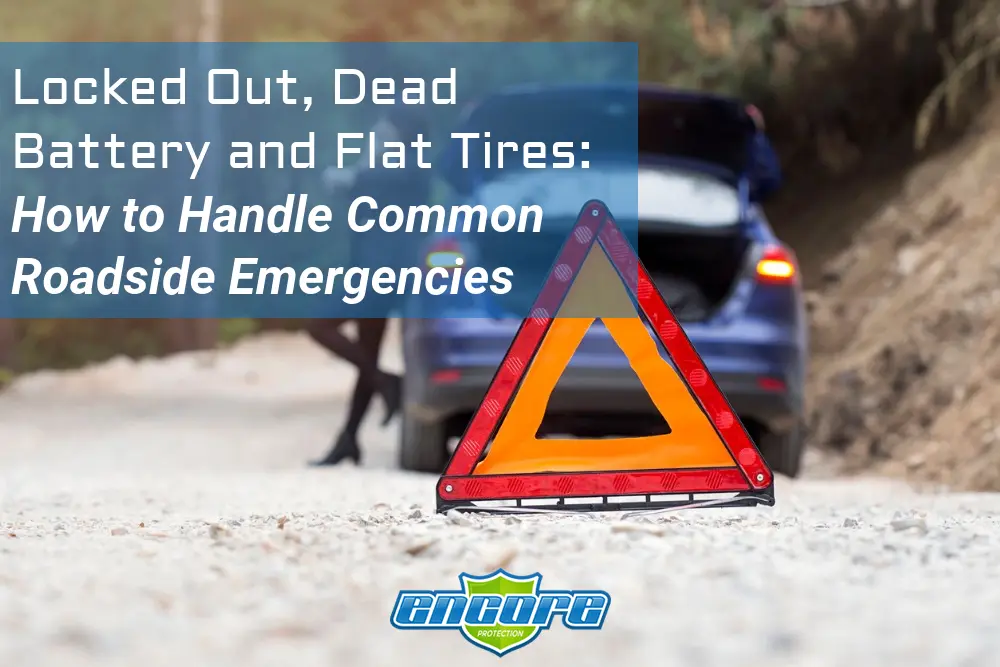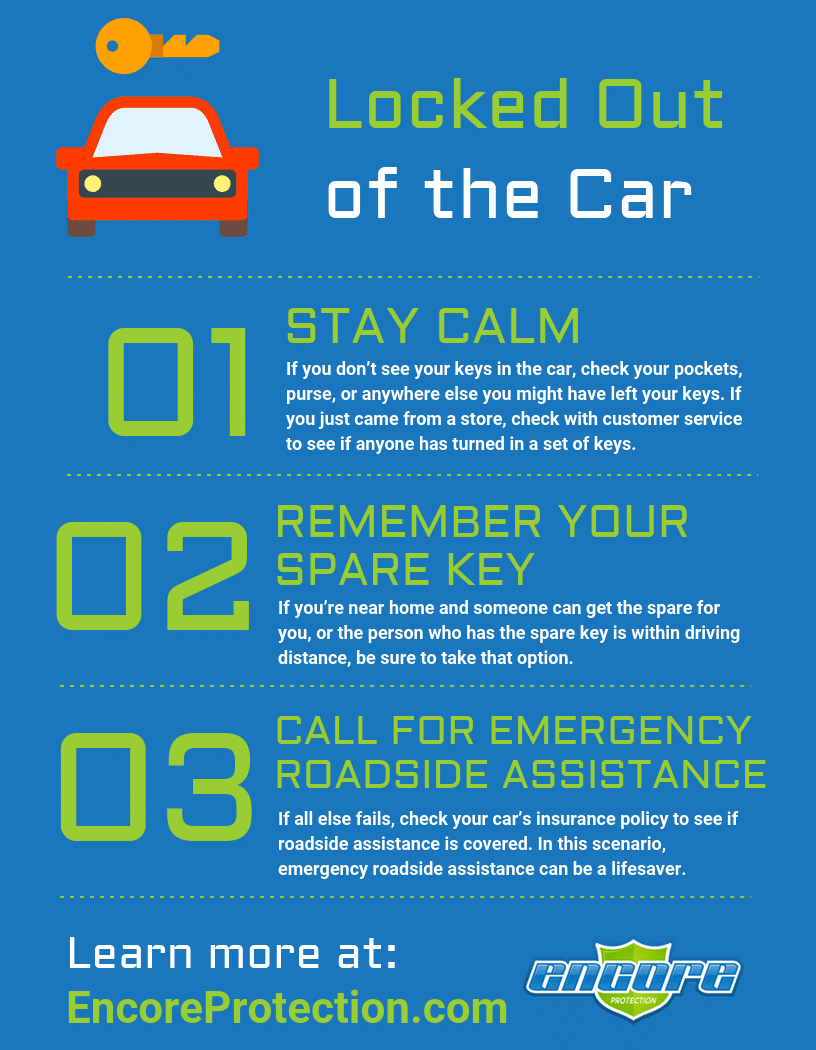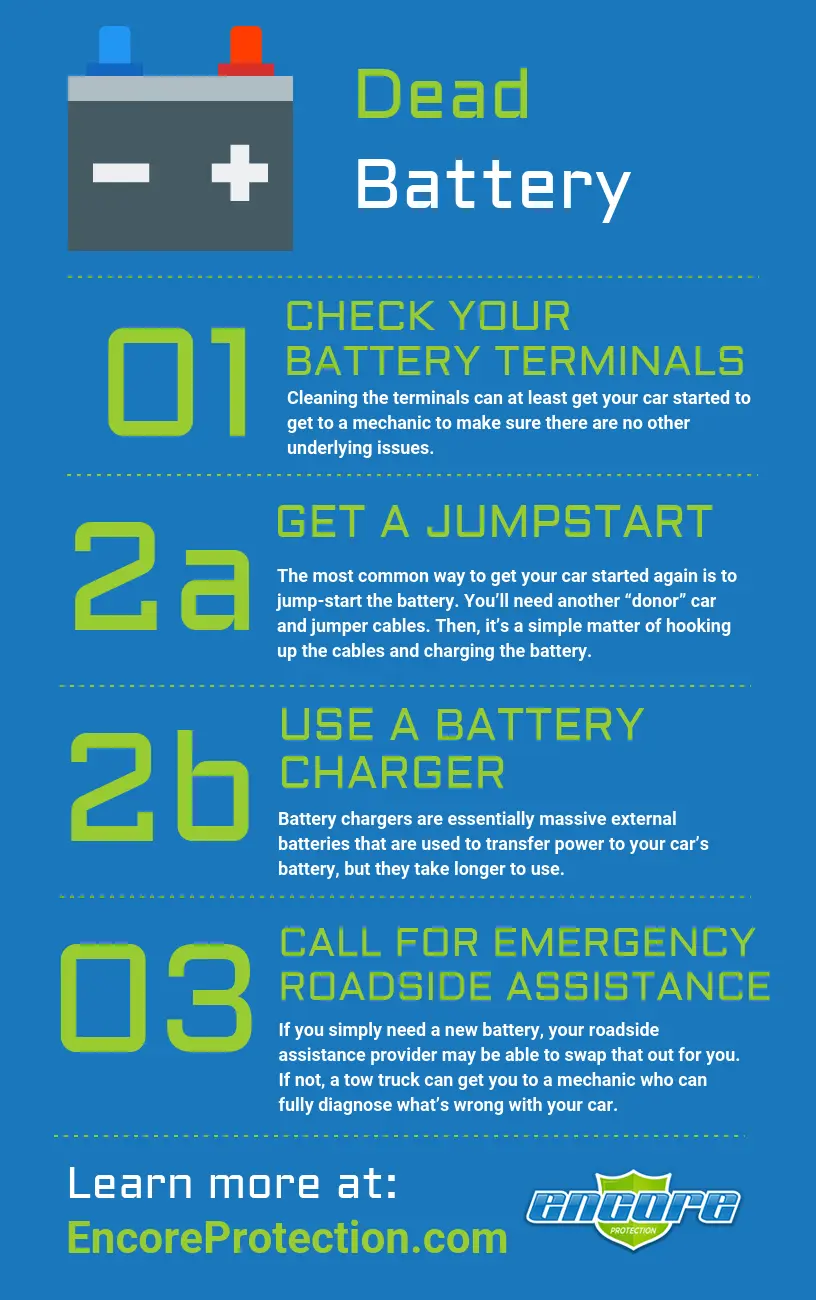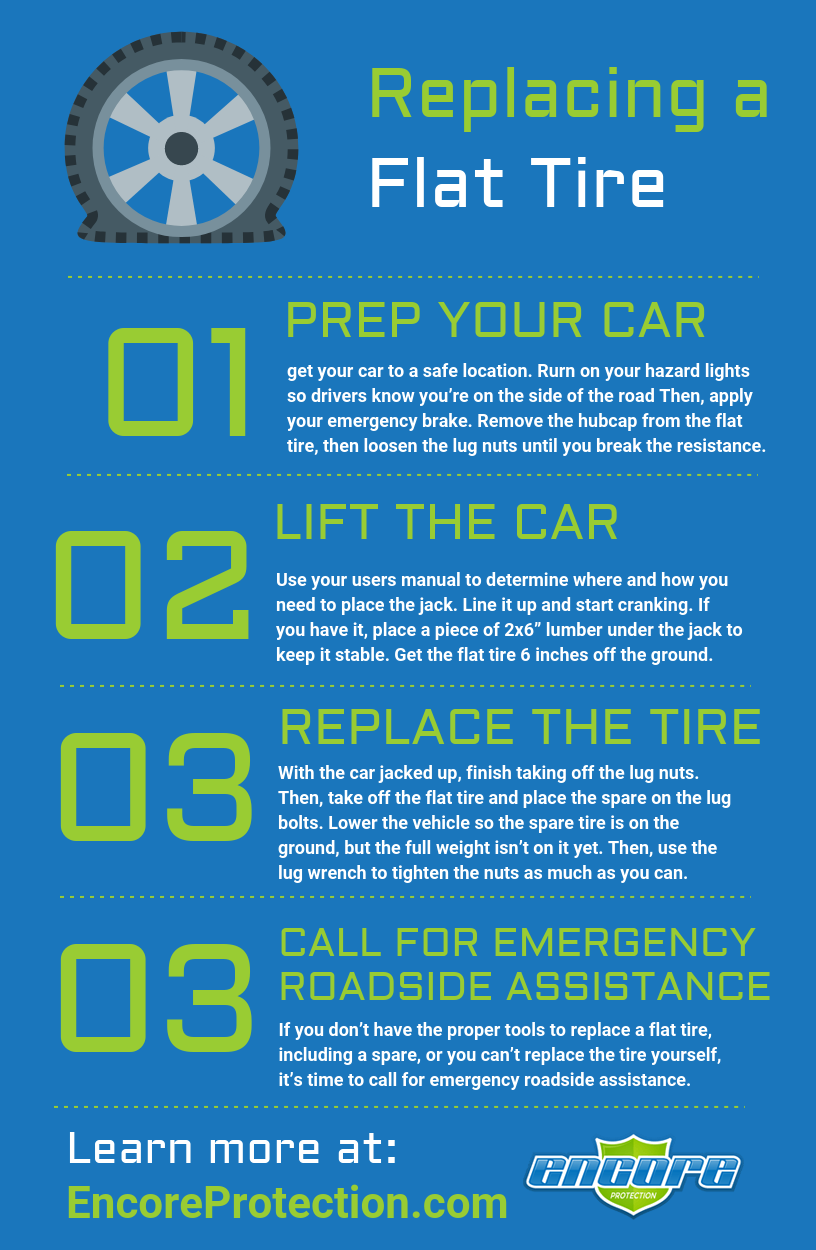
Whether you’re heading on a cross-country road trip or running some errands in town, having a roadside emergency is always frustrating. Getting off-schedule can ruin your day — or your entire trip. A few of the most common roadside emergencies include getting locked out of your car, finding yourself with a dead battery, and getting a flat tire.
There are plenty of ways you can handle these issues by yourself, especially if you know what you’re doing. But if you can’t figure it out or simply don’t want to do it yourself, Encore Protection’s on-demand emergency roadside assistance service (coming soon!) can help. Be sure to stay tuned for our announcement when this service goes live!
In the meantime, here are a few tips to get you back on the road if you lock yourself out of your car, get a dead battery, or find yourself with a flat tire.
Locked Out of the Car
Getting locked out of your car is perhaps the most frustrating emergency on this list, due to the sheer fact that it’s the most avoidable. Rather than being embarrassed or beating yourself up, however, follow these steps to get back in the car.
Note that these steps are intended for those who have time to get their car opened. If you have a pet or infant in the car and they are in danger, call the police immediately or, if absolutely necessary, break your car’s window to retrieve your keys. Breaking car windows is dangerous and can cause injury. Encore Protection assumes no liability for any injury incurred.
1. Stay Calm
There’s a good chance just about everyone you know has locked their keys in their car at some point. So, don’t panic. Before you do anything else, recheck all the doors on your car to see if any are open — including the truck.
If you don’t see your keys in the car, check your pockets, purse, or anywhere else you might have left your keys. If you just came from a store, check with customer service to see if anyone has turned in a set of keys. Many times, the keys won’t be locked in the car; rather, you may just forget where you put them.
2. Remember Where Your Spare Key Is?
If you bought a car from a dealership, chances are you received at least two sets of keys, even if they’re expensive keys to duplicate. If you’re near home and someone can get the spare for you, or the person who has the spare key is within driving distance, be sure to take that option. It’s by far the cheapest.
If you’re planning for the future, be sure to get a spare key made, and know where it is at all times. If you have a key that’s expensive to duplicate due to the security features in the key, see if there’s an option to make a key that will at least open the door, even if it won’t start the car. If not, investing in a full duplicate is worth the cost.
3. Call for Emergency Roadside Assistance
If all else fails, check your car’s insurance policy to see if roadside assistance is covered. If not, you’ll be on the hook for the cost. In this scenario, emergency roadside assistance can be a lifesaver.

Dead Battery
If your car battery is dead, you will most likely need to get it jump-started. However, this may not always be the case. In some cases, you may need a new battery altogether, or the issue may be a different electrical component like your alternator or starter. Follow these steps if you find yourself with a dead battery.
1. Check Your Battery Terminals
If you have a relatively new battery that shouldn’t be dying yet, your first step should be to check the battery terminals (the metal rings that connect the battery to the car). Any kind of white, green or blue buildup on the terminals can cause a poor connection. Cleaning the terminals can at least get your car started to get to a mechanic to make sure there are no other underlying issues.
You will need a few tools to clean off the corrosion, but they can be found at just about any store. Be sure to get rubber gloves, a rag, and a stiff wire or plastic brush. You’ll also need a socket wrench to get the terminals off the battery. Once you get the terminals off the battery, you’ll want to use the brush to clean off the corrosion, wipe it down with a rag, then replace them. If this doesn’t work, your terminals may not be the issue.
2a. Get a Jumpstart
The most common way to get your car started again is to jump-start the battery. You’ll need another “donor” car and jumper cables. Then, it’s a simple matter of hooking up the cables and charging the battery.
First, connect the jumper cables to the dead car (red is positive[+], black is negative[-]). Once they’re secured, connect the other side of the cables to the donor car — but make sure the donor car is off. Once the cables are connected, start the donor car and let it run for one to five minutes.
After a few minutes, try to start up your own car. If it starts up, leave it running while you carefully remove the jumper cables, making sure you don’t touch the claws together. Drive your car around for at least 30 minutes to make sure the battery fully charges.
2b. Use a Battery Charger
Similar to getting a jumpstart, a battery charger can be a lifesaver when you have a dead battery. These are essentially massive external batteries that are used to transfer power to your car’s battery. While they take longer to use, they can be more convenient if you’re stranded.
First, hook up the charging cables to your battery. Then, either plug in the charger or simply turn it on (depending on the model you have) and let the battery charge. Ideally, you want to wait until it’s fully charged before you turn it off, but in a pinch, letting it charge for at least a couple hours can get you to a mechanic.
3. Call for Emergency Roadside Assistance
If all else fails, call for emergency roadside assistance. If you simply need a new battery, your roadside assistance provider may be able to swap that out for you. If not, a tow truck can get you to a mechanic who can fully diagnose what’s wrong with your car.

Flat Tire
A flat tire can be a relatively easy fix. Most cars come with a spare tire and simple tools needed to swap out the tire. However, it’s important to note that you should never drive more than 70 miles, and no faster than 50 miles per hour, on a spare “donut.” Otherwise, you could damage both the wheel and your car as a whole.
Follow these steps if you find yourself with a flat tire:
1. Prep Your Car
If you can, get your car to a safe location where you can change out the tire. Then, turn on your hazard lights so drivers know you’re on the side of the road — especially at night. Then, apply your emergency brake, and if you have them, set tire wedges or large stones in front of the tires.
Remove the hubcap from the flat tire, if applicable. This can usually be done with the flat side of the lug wrench. Then, loosen the lug nuts until you break the resistance. You may have to step on the lug wrench to loosen them up. Don’t worry about them breaking.
2. Lift the Car
Next, use your users manual to determine where and how you need to place the jack. Most cars will have some kind of flat area specifically designed to take the pressure of lifting the car with the jack. Line it up and start cranking. If you have it, place a piece of 2×6” lumber under the jack to keep it stable.
With the jack that comes with your car, it’s going to take some time and elbow grease to get the flat tire to the recommended 6 inches off the ground. Make sure the tire isn’t too high or low. Too low, and it’ll be difficult to work. Too high, and your car might come off the jack.
3. Replace the Tire
With the car jacked up, finish taking off the lug nuts. Then, take off the flat tire and place the spare on the lug bolts. Be sure it’s on the right way; the air valve should face outwards! Then, put the lug nuts back on and tighten them by hand.
Lower the vehicle so the spare tire is on the ground, but the full weight isn’t on it yet. Then, use the lug wrench to tighten the nuts as much as you can. Use your full body weight if you need to. Finally, lower the car back onto the ground completely, and replace the hubcap. Check the air pressure in the tire to make sure it’s about 60 psi, or whatever pressure level is on the tire.
Again, don’t drive on the spare for too long. Be sure to get it replaced with a real tire as soon as possible.
4. Call for Emergency Roadside Assistance
If you don’t have the proper tools to replace a flat tire, including a spare, or you can’t replace the tire yourself, it’s time to call for emergency roadside assistance. They can either replace your flat with a spare right there, or they can tow you to a mechanic to get a new tire.

Emergency Roadside Assistance Is Key
Yes, you can fix a flat tire, fish out the keys you locked in your car, and jump a dead battery on your own. But in many instances, this simply isn’t feasible. That’s where emergency roadside assistance becomes a necessity.
At Encore Protection, our on-demand emergency roadside assistance services (coming soon!) can get you back on the road in no time. In the meantime, find out more about our current consumer roadside assistance plans.

Comments are closed